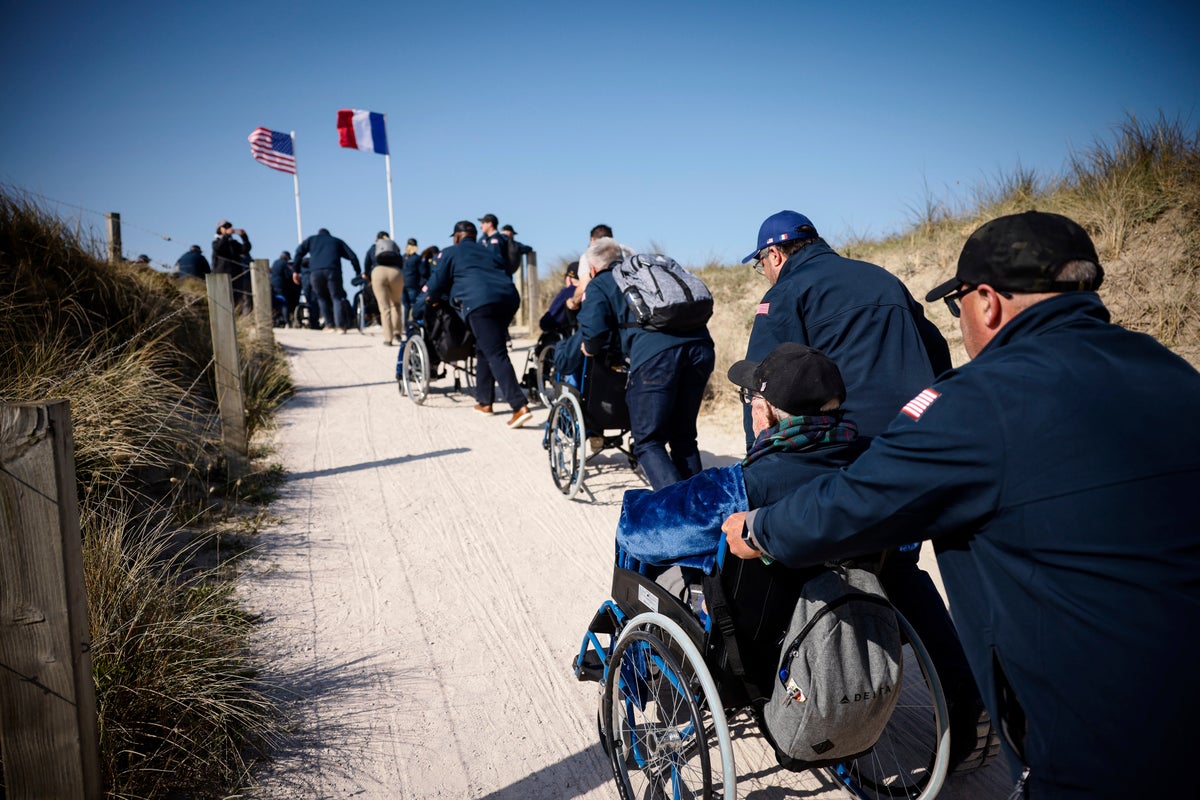
Looking at the vastness of Utah Beach, its sand blowing in strong wind and bright sunshine, made Robert Gibson's memory of D-Day even more vivid.
“It was tough,” the 99-year-old veteran said of the moment when he landed there on June 6, 1944 alongside more than 150,000 other Allied troops.
Gibson was among dozens of World War II veterans, mostly Americans and British, who traveled to Normandy this week to mark the 79th anniversary of D-Day, commemorating the decisive assault that led to the liberation of France and Western Europe from Nazi control.
He remembered “lots of casualties. We had almost run over bodies to get in the beach. Never forget we were only 18, 19 years old. ... I’m glad I made it.”
Gibson landed on Utah Beach on D-Day in the second wave, after the assault troops. He survived to continue fighting in Normandy and eventually into Germany.
The first job of his battalion, he said, was "to guard an ammunition dump and the first night it got struck. You didn’t know where you were to go. Bullets were going all over the place. But we ducked it.”
Andrew Negra also landed on Utah Beach. That was on July 18, 1944. He returned for the first time this year and was “amazed” by the warm welcome from local French people.
“Every place we went, people are cheering, clapping, and they’ve been doing this for I don’t know how many years,” he said.
At age 99, Negra is the only member of his battalion who is still alive. Braving the wind to walk on the beach for a few minutes, he said, “So many we lost. And here I am.”
Negra participated in combat operations until his division reached eastern Germany in April 1945.
On Sunday, over 40 American veterans of World War II formed a parade, using wheelchairs, along the streets of the small town of Sainte-Mere-Eglise, where thousands of paratroopers jumped not long after midnight on June 6, 1944.
Cheerful crowds applauded, calling out “Merci" and “Thank you.” Children waved, and many families asked for a photo with the men.
Donnie Edwards, president of the Best Defense Foundation, a non-profit organization that helps World War II veterans visit former battlefields, said, “For us, every year is a big one.”
Given the ages of the soldiers who fought more than seven decades ago, Edwards observed, “Nothing is guaranteed. So we want to make sure that we do everything we can to get them an incredible and enjoyable experience.”
The veterans then headed to Sainte-Marie-du-Mont for a brief ceremony at a monument honoring the U.S. Navy that overlooks Utah Beach.
“The fallen will never be forgotten. The veteran will ever be honored,” an inscription in the stone reads.
Some of the almost-centenarians asked volunteers to accompany them on the wide stretch of sand.
Matthew Yacovino, 98, became emotional as he remembered what happened there to his older brother, who almost died after his jeep blown up during the landings.
“The driver got killed and my brother fell on the beach unconscious," Yacovino said with tears in the eyes.
His brother eventually recovered. Yacovino himself served as a combat air crewman during the war.
Like others who come to Normandy for historical reenactments of what transpired there, Valérie and Lionel Draucourt, visitors from the Paris region, dressed in khaki uniforms. They wanted to pay their respects to the veterans.
“Frankly, I don’t think we can quite fathom what they lived through. We can’t understand it, it’s so big, it’s crazy,” Lionel Draucourt said.
Veterans were due to take part in official ceremonies of the 79th anniversary on Tuesday, including at the Normandy American Cemetery.
On D-Day, Allied troops landed on the beaches code-named Omaha, Utah, Juno, Sword and Gold, carried by 7,000 boats. On that single day, 4,414 Allied soldiers lost their lives, 2,501 of them Americans. More than 5,000 were wounded.
On the German side, several thousand were killed or wounded.
U.S. Joint Chiefs chairman, Gen. Mark Milley, stressed the significance of the commemorations “for memorializing the efforts that they did and what they did."
"They were fighting to make sure that fascism and Nazism didn’t stay in control of Europe. Ultimately, we all know that they were successful,” Milley said.







